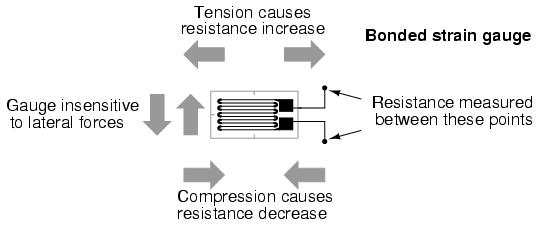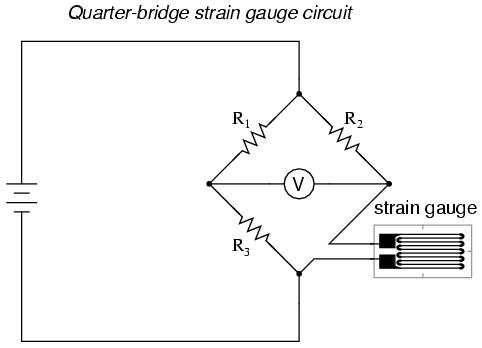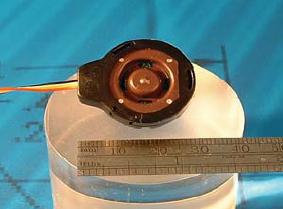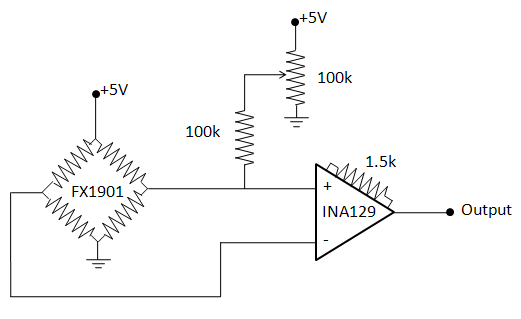Difference between revisions of "Strain Gauge"
m |
|||
| (8 intermediate revisions by 2 users not shown) | |||
| Line 1: | Line 1: | ||
===Overview=== |
===Overview=== |
||
Strain gauges are simple sensors that can be used to measure forces. They consist peice of conducting material that changes resistance as it is stretched in a given direction. The diagram below shows this: |
|||
[[image:strain gauge.jpg|center]] |
|||
===Circuitry=== |
===Circuitry=== |
||
Typically, the change in resistance of the strain gauge is very small. In order to accurately measure this small change, special circuitry is needed. For this, a ''wheatstone bridge'' configuration is usually employed. There are variants on how this circuit can be arranged; two are presented below. |
|||
The first configuration is the simplest method. The wheatstone bridge measures small imbalances in the resistances. Here it is comparing the strain gauge resistance to <math>R_3</math>, which has a resistance equal to the resistance of the unstretched strain gauge. The other two resistors should have similar values. |
|||
[[image:simple strain guage circuit.jpg|center]] |
|||
Next is a more advanced circuit used for measuring strain in both directions. Two strain gauges are used, and must be positioned carefully, as shown in the second figure. |
|||
{| align="center" |
|||
|- |
|||
| [[image:advanced strain gauge circuit.jpg|300px]] |
|||
| [[image:advanced strain gauge attachment.jpg|300px]] |
|||
|} |
|||
===Example Usage=== |
|||
The FX1901 is an inexpensive 1% strain gauge that can be used for a variety of applications. It is available for about $30 and comes in 10, 25, 50, and 100 lbf models |
|||
[[image:FX1901.jpg]] |
|||
Here is an example set up circuit with amplifier amp and tuning potentiometer: |
|||
[[Image:ForceSensorCircuitDiagram.jpg]] |
|||
Ensure that the power lines are very stable, it is suggested that in noisy environments, a DC-DC converter, power regulator(L78L05) and large power capacitors are used to ensure clean signal. In more ideal environments, a simple capacitor across the power lines should be sufficient. |
|||
==References== |
==References== |
||
Latest revision as of 11:06, 4 February 2011
Overview
Strain gauges are simple sensors that can be used to measure forces. They consist peice of conducting material that changes resistance as it is stretched in a given direction. The diagram below shows this:
Circuitry
Typically, the change in resistance of the strain gauge is very small. In order to accurately measure this small change, special circuitry is needed. For this, a wheatstone bridge configuration is usually employed. There are variants on how this circuit can be arranged; two are presented below.
The first configuration is the simplest method. The wheatstone bridge measures small imbalances in the resistances. Here it is comparing the strain gauge resistance to , which has a resistance equal to the resistance of the unstretched strain gauge. The other two resistors should have similar values.
Next is a more advanced circuit used for measuring strain in both directions. Two strain gauges are used, and must be positioned carefully, as shown in the second figure.
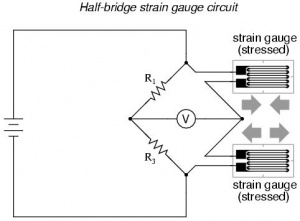
|
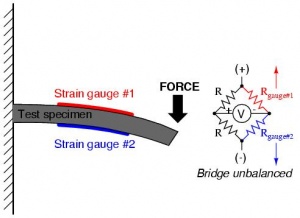
|
Example Usage
The FX1901 is an inexpensive 1% strain gauge that can be used for a variety of applications. It is available for about $30 and comes in 10, 25, 50, and 100 lbf models
Here is an example set up circuit with amplifier amp and tuning potentiometer:
Ensure that the power lines are very stable, it is suggested that in noisy environments, a DC-DC converter, power regulator(L78L05) and large power capacitors are used to ensure clean signal. In more ideal environments, a simple capacitor across the power lines should be sufficient.
